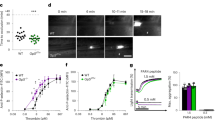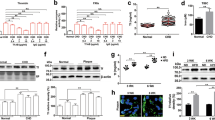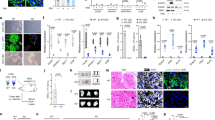Abstract
Disruption of the mouse gene encoding the blood coagulation inhibitor thrombomodulin (Thbd) leads to embryonic lethality caused by an unknown defect in the placenta. We show that the abortion of thrombomodulin-deficient embryos is caused by tissue factor–initiated activation of the blood coagulation cascade at the feto-maternal interface. Activated coagulation factors induce cell death and growth inhibition of placental trophoblast cells by two distinct mechanisms. The death of giant trophoblast cells is caused by conversion of the thrombin substrate fibrinogen to fibrin and subsequent formation of fibrin degradation products. In contrast, the growth arrest of trophoblast cells is not mediated by fibrin, but is a likely result of engagement of protease-activated receptors (PAR)-2 and PAR-4 by coagulation factors. These findings show a new function for the thrombomodulin–protein C system in controlling the growth and survival of trophoblast cells in the placenta. This function is essential for the maintenance of pregnancy.
This is a preview of subscription content, access via your institution
Access options
Subscribe to this journal
Receive 12 print issues and online access
$209.00 per year
only $17.42 per issue
Buy this article
- Purchase on Springer Link
- Instant access to full article PDF
Prices may be subject to local taxes which are calculated during checkout





Similar content being viewed by others
References
Esmon, C.T. Regulation of blood coagulation. Biochim. Biophys. Acta 1477, 349–360 (2000).
Taylor, F.B., Peer, G.T., Lockhart, M.S., Ferrell, G. & Esmon, C.T. Endothelial cell protein C receptor plays an important role in protein C activation in vivo. Blood 97, 1685–1688 (2001).
Healy, A.M., Rayburn, H.B., Rosenberg, R.D. & Weiler, H. Absence of the blood-clotting regulator thrombomodulin causes embryonic lethality in mice before development of a functional cardiovascular system. Proc. Natl. Acad. Sci. USA 92, 850–854 (1995).
Weiler-Guettler, H., Aird, W.C., Rayburn, H., Husain, M. & Rosenberg, R.D. Developmentally regulated gene expression of thrombomodulin in postimplantation mouse embryos. Development 122, 2271–2281 (1996).
Weiler-Guettler, H., Aird, W.C., Husain, M., Rayburn, H. & Rosenberg, R.D. Targeting of transgene expression to the vascular endothelium of mice by homologous recombination at the thrombomodulin locus. Circ. Res. 78, 180–187 (1996).
Isermann, B., Hendrickson, S.B., Hutley, K., Wing, M. & Weiler, H. Tissue-restricted expression of thrombomodulin in the placenta rescues thrombomodulin-deficient mice from early lethality and reveals a secondary developmental block. Development 128, 827–838 (2001).
Weiler-Guettler, H. et al. A targeted point mutation in thrombomodulin generates viable mice with a prethrombotic state. J. Clin. Invest. 101, 1983–1991 (1998).
Zhang, Y. et al. Thrombomodulin modulates growth of tumor cells independent of its anticoagulant activity. J. Clin. Invest. 101, 1301–1309 (1998).
Wang, W., Nagashima, M., Schneider, M., Morser, J. & Nesheim, M. Elements of the primary structure of thrombomodulin required for efficient thrombin-activable fibrinolysis inhibitor activation. J. Biol. Chem. 275, 22942–22947 (2000).
Nesheim, M. et al. Thrombin, thrombomodulin and TAFI in the molecular link between coagulation and fibrinolysis. Thromb. Haemost. 78, 386–391 (1997).
Weitz, J.I., Hudoba, M., Massel, D., Maraganore, J. & Hirsh, J. Clot-bound thrombin is protected from inhibition by heparin-antithrombin III but is susceptible to inactivation by antithrombin III-independent inhibitors. J. Clin. Invest. 86, 385–391 (1990).
Zivelin, A., Rao, L.V. & Rapaport, S.I. Mechanism of the anticoagulant effect of warfarin as evaluated in rabbits by selective depression of individual procoagulant vitamin K- dependent clotting factors. J. Clin. Invest. 92, 2131–2140 (1993).
Carmeliet, P. et al. Role of tissue factor in embryonic blood vessel development. Nature 383, 73–75 (1996).
Bugge, T.H. et al. Fatal embryonic bleeding events in mice lacking tissue factor, the cell- associated initiator of blood coagulation. Proc. Natl. Acad. Sci. USA 93, 6258–6263 (1996).
Toomey, J.R., Kratzer, K.E., Lasky, N.M., Stanton, J.J. & Broze, G.J. Targeted disruption of the murine tissue factor gene results in embryonic lethality. Blood 88, 1583–1587 (1996).
Parry, G.C., Erlich, J.H., Carmeliet, P., Luther, T. & Mackman, N. Low levels of tissue factor are compatible with development and hemostasis in mice. J. Clin. Invest. 101, 560–569 (1998).
Erlich, J. et al. Tissue factor is required for uterine hemostasis and maintenance of the placental labyrinth during gestation. Proc. Natl. Acad. Sci. USA 96, 8138–8143 (1999).
Suh, T.T. et al. Resolution of spontaneous bleeding events but failure of pregnancy in fibrinogen-deficient mice. Genes Dev. 9, 2020–2033 (1995).
Tanaka, S., Kunath, T., Hadjantonakis, A.K., Nagy, A. & Rossant, J. Promotion of trophoblast stem cell proliferation by FGF4. Science 282, 2072–2075 (1998).
Ratts, V.S. et al. Expression of BCL-2, BAX and BAK in the trophoblast layer of the term human placenta: a unique model of apoptosis within a syncytium. Placenta 21, 361–366 (2000).
Toki, T. et al. Inverse relationship between apoptosis and Bcl-2 expression in syncytiotrophoblast and fibrin-type fibrinoid in early gestation. Mol. Hum. Reprod. 5, 246–251 (1999).
Tsumagari, T. & Tanaka, K. Effects of fibrinogen degradation products on glomerular mesangial cells in culture. Kidney Int. 26, 712–718 (1984).
Frisch, S.M. & Screaton, R.A. Anoikis mechanisms. Curr. Opin. Cell Biol. 13, 555–562 (2001).
Buckley, C.D. et al. RGD peptides induce apoptosis by direct caspase-3 activation. Nature 397, 534–539 (1999).
Teesalu, T., Blasi, F. & Talarico, D. Expression and function of the urokinase type plasminogen activator during mouse hemochorial placental development. Dev. Dyn. 213, 27–38 (1998).
Strickland, S. & Richards, W.G. Invasion of the trophoblasts. Cell 71, 355–357 (1992).
Hu, Z.Y. et al. Expression of tissue type and urokinase type plasminogen activators as well as plasminogen activator inhibitor type-1 and type-2 in human and rhesus monkey placenta. J. Anat. 194, 183–195 (1999).
Riewald, M., Petrovan, R.J., Donner, A., Mueller, B.M. & Ruf, W. Activation of endothelial cell protease activated receptor 1 by the protein C pathway. Science 296, 1880–1882 (2002).
Connolly, A.J., Ishihara, H., Kahn, M.L., Farese, R.V. & Coughlin, S.R. Role of the thrombin receptor in development and evidence for a second receptor. Nature 381, 516–519 (1996).
Gu, J.M. et al. Disruption of the endothelial cell protein C receptor gene in mice causes placental thrombosis and early embryonic lethality. J. Biol. Chem. 277, 43335–43343 (2002).
Crawley, J.T., Gu, J.M., Ferrell, G. & Esmon, C.T. Distribution of endothelial cell protein C/activated protein C receptor (EPCR) during mouse embryo development. Thromb. Haemost. 88, 259–266 (2002).
Coughlin, S.R. Thrombin signalling and protease-activated receptors. Nature 407, 258–264 (2000).
Cross, J.C., Werb, Z. & Fisher, S.J. Implantation and the placenta: key pieces of the development puzzle. Science 266, 1508–1518 (1994).
Fazel, A. et al. Increase in expression and activity of thrombomodulin in term human syncytiotrophoblast microvilli. Placenta 19, 261–268 (1998).
Even-Ram, S. et al. Thrombin receptor overexpression in malignant and physiological invasion processes. Nat. Med. 4, 909–914 (1998).
Preston, F.E. et al. Increased fetal loss in women with heritable thrombophilia. Lancet 348, 913–916 (1996).
Greer, I.A. Thrombosis in pregnancy: maternal and fetal issues. Lancet 353, 1258–1265 (1999).
Kupferminc, M.J. et al. Increased frequency of genetic thrombophilia in women with complications of pregnancy. N. Engl. J. Med. 340, 9–13 (1999).
Brenner, B. et al. Thrombophilic polymorphisms are common in women with fetal loss without apparent cause. Thromb. Haemost. 82, 6–9 (1999).
Blumenfeld, Z. & Brenner, B. Thrombophilia-associated pregnancy wastage. Fertil. Steril. 72, 765–774 (1999).
Out, H.J., Kooijman, C.D., Bruinse, H.W. & Derksen, R.H. Histopathological findings in placentae from patients with intra-uterine fetal death and anti-phospholipid antibodies. Eur. J. Obstet. Gynecol. Reprod. Biol. 41, 179–186 (1991).
Isermann, B. et al. Endothelium-specific loss of murine thrombomodulin disrupts the protein C anticoagulant pathway and causes juvenile-onset thrombosis. J. Clin. Invest. 108, 537–546 (2001).
Gogjian, M.A., Barry, K.J. & Stein, B.M. Measurement of fibrinolytic activity after ε-aminocaproic acid administration in rats (Rattus norvegicus). Lab Anim. Sci. 31, 710–711 (1981).
Braissant, O. & Wahli, W. A simplified in situ hybridization protocol using non-radioactively labeled probes to detect abundant and rare mRNAs on tissue sections. Biochemica 3, 10–16 (1998).
Rappolee, D.A., Basilico, C., Patel, Y. & Werb, Z. Expression and function of FGF-4 in peri-implantation development in mouse embryos. Development 120, 2259–2269 (1994).
Acknowledgements
This work was supported by NIH grant HL-60655, by a grant-in-aid from the American Heart Association to H.W. and by a grant of the Deutsche Forschungsgemeinschaft (IS 67/1-2) to B.I.
Author information
Authors and Affiliations
Corresponding author
Ethics declarations
Competing interests
The authors declare no competing financial interests.
Rights and permissions
About this article
Cite this article
Isermann, B., Sood, R., Pawlinski, R. et al. The thrombomodulin–protein C system is essential for the maintenance of pregnancy. Nat Med 9, 331–337 (2003). https://doi.org/10.1038/nm825
Received:
Accepted:
Published:
Issue Date:
DOI: https://doi.org/10.1038/nm825
This article is cited by
-
Gestational hemostasis: a natural model for hemostasis resuscitation of major periprocedural blood loss
Perioperative Medicine (2021)
-
Spontaneous embryo resorption in the mouse is triggered by embryonic apoptosis followed by rapid removal via maternal sterile purulent inflammation
BMC Developmental Biology (2020)
-
A thrombomodulin-like gene is crucial to the collective migration of epibolic blastomeres during germ layer formation and organogenesis in zebrafish
Journal of Biomedical Science (2019)
-
THBD sequence variants potentially related to recurrent pregnancy loss
Reproductive Biology and Endocrinology (2017)
-
Venöse Thromboembolien, Thrombophilie und Thromboseprophylaxe in Gynäkologie und Geburtshilfe
Der Gynäkologe (2015)



